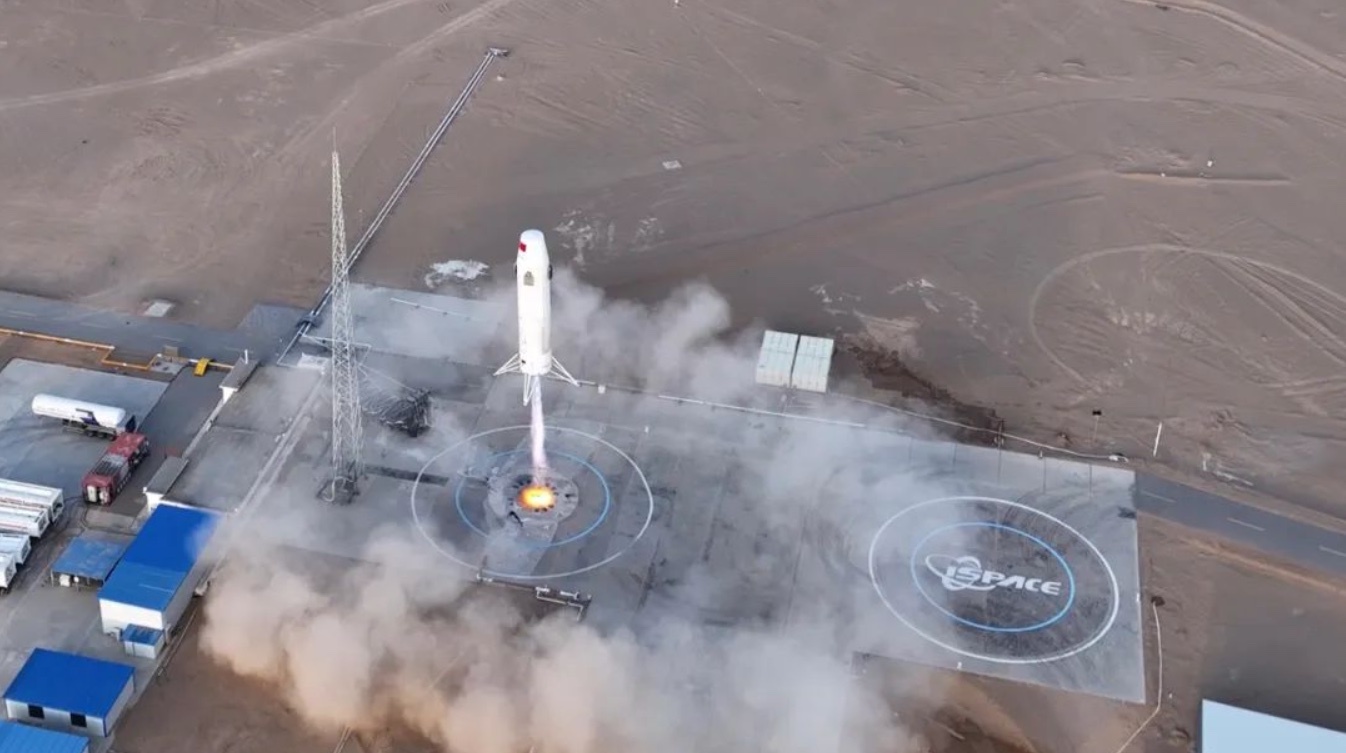13.12.2023

The iSpace Hyperbola-2Y test article during a hop test, Dec. 10, 2023. Credit: iSpace
HELSINKI — Launch startup iSpace has successfully launched and landed a test article, a month after a first hop test, as Chinese reusable rocket efforts intensify.
ISpace’s Hyperbola-2Y methane-liquid oxygen reusable verification stage lifted off from a pad at Jiuquan Satellite Launch Center in the Gobi Desert at 4:07 a.m. Eastern (1107 UTC) Dec. 10.
The Hyperbola-2Y reached an altitude of 343.12 meters, translating 50 meters to a landing zone and touching down with a velocity of 1.1 meters per second and an accuracy of 0.295 meters. The entire flight lasted 63.15 seconds, according to an iSpace press statement.
The flight came just over a month after a first hop test Nov. 2. That test reached 178 meters and returned to its landing spot. iSpace says it will attempt a test at sea next year after completing ground tests.
The company said the flight obtained further flight data of and provided a basis for the company’s ongoing development of the Hyperbola-3 reusable launch vehicle provides key technology verification.
The company is targeting a first flight of the 13.4-metric-ton to low Earth orbit (LEO) Hyperbola-3 rocket in 2025. A demonstration of recovering and reusing a first stage will follow in 2026. The 69-meter-long rocket will be able to lift 8.5 tons to LEO in reusable mode. iSpace says it aims to conduct 25 Hyperbola-3 launches per year by 2030.
The tests come years after Chinese commercial firms first announced plans to develop launchers with reusable first stages. Other companies, which began emerging after a Chinese policy shift in late 2014, are seemingly not far behind.
Fellow Beijing-based competitor Landspace is also gearing up for its first hop test. That will also take place at Jiuquan and before the end of the year.
The test is part of the development of the newly-announced, two-stage methalox Zhuque-3. Landspace aims to fly the stainless steel rocket for the first time in 2025.
The rocket will be 4.5 meters in diameter and have a total length of 76.6 meters. It will have a payload capacity to LEO will be 21,000 kilograms when expendable. It will carry up to 18,300 kg when the first stage is recovered downrange, or 12,500 kg when returning to the launch site.
Landspace revealed details of the Zhuque-3 and imminent hop test plans following the second successful flight of its methalox Zhuque-2 over the weekend.
Elsewhere in China, Galactic Energy performed a hop test with a jet engine-powered test article in August. The test is part of development of the Pallas-1 kerosene-liquid oxygen reusable launcher. A first, expendable flight is planned for the third quarter of 2024.
CAS Space, a spin-off from the Chinese Academy of Sciences, has likewise conducted such tests. These were used to verify algorithms for vertical takeoff, vertical landing (VTVL) rockets.
Another firm, Jiangsu-based Deep Blue Aerospace, is meanwhile planning the first flight of its Nebula-1 kerolox rocket in 2024. The launch will take place from commercial launch facilitiesnear the Wenchang Satellite Launch Center on Hainan island.
The firm conducted a kilometer-level hop test in May 2022. Unlike iSpace’s recent hops, that test did not use a rocket engine intended for orbital flights.
Space Pioneer, the first Chinese commercial startup to reach orbit with a liquid propellant rocket, is planning to launch its Tianlong-3 rocket in June 2024. The rocket will be comparable to Falcon 9 in launch capability and eventually have a reusable first stage.
China’s state-owned main space contractor CASC is also aiming for reusable rockets. This includes a new-generation human-rated launcher for lunar crewed missions and an evolving Long March 9 super heavy-lift launcher.
CASC is also considering a reusable air-launched rocket. It is also developing a two-stage spaceplane concept. It uses a reusable VTHL suborbital first stage and a reusable spacecraft second stage.
A third flight of the reusable orbital spaceplane is expected to launch via a Long March 2F Dec. 14, according to newly-released airspace closure notices.
| Company | Rocket Name | Rocket Type | Key Features or Notes |
|---|---|---|---|
| iSpace | Hyperbola-3 | Methane-liquid oxygen reusable | Payload capacity of 8,500 kg to Low Earth Orbit (LEO); first flight planned for 2025. |
| Landspace | Zhuque-3 | Methalox reusable | Payload capacity up to 21,000 kg to LEO; first flight planned for 2025. |
| Galactic Energy | Pallas-1 | Kerosene-liquid oxygen reusable | Payload capacity of 5,000 kg to LEO, or 3,000 kg to a 700 km sun-synchronous orbit (SSO). |
| CAS Space | Kinetica 2 | Kerolox reusable | Payload capacity of 7,800 kg to 500 km SSO. |
| Deep Blue Aerospace | Nebula-1 | Kerolox reusable | Payload capacity of 1,000 kg to 500 km SSO; first flight planned in late 2024. |
| Space Pioneer | Tianlong-3 | Kerolox | Comparable to Falcon 9 in launch capability; plans for a reusable first stage. |
| CASC | Various | Various | Working on reusable rockets including a new-generation human-rated launcher and Long March 9 super heavy-lift launcher. |

